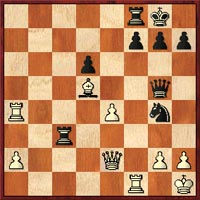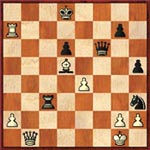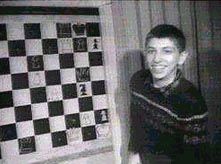 |
 |
 |
 |
 |
 |
 |
 |
 |
 |
 |
 |
 |
 |
 |
 |
|
|
|
|
|
|
|
|
|
|
|
|
|
|
|
|
|
 |
|
|
|
|
|
|
|
|
Fischer's "Other Queen Sac"
|
|
|
|
|
|
|
|
|
|
|
|
|
For those unfamiliar with Dutchman Tim Krabbé's "Open Chess Diary," you're missing some entertaining chess lore. The Chess Drum featured one such story about Archie Waters, a Black companion of Bobby Fischer. Entry #28 (30 October 1999) has another story about Fischer, this time as a 14-year old phenom from Brooklyn who dazzled the world with his chess wizardry. In the featured game, Fischer finishes off an beleaguered opponent with an array of tactics highlighted by a nice Queen sac. No it isn't the famous D. Byrne- Fischer game (New York, 1956), but Fischer-Sherwin from the 1957 U.S. Championship. A few notes and an extra diagram have been added.
Now Krabbé makes the call! Enjoy!
|
|
|
|
|
|
|
|
|
 |
|
|
|
|
|
|
|
|
"A Winning Smile"
In that documentary 'Clash of the Titans' (see item 27), there was also some footage of Fischer I had never seen: 14-year old Bobby at a demonstration board, showing a position I recognized as Fischer-Sherwin from his first American championship. At the time it was analysed extensively in Holland by Kramer and Crabbendam, whose findings have perhaps not yet entered the Fischer-story.
|
|
|
|
|
|
|
|
|
|
|
|
|
30.Rxf7 A great coup, probably the best move, but perhaps not winning. 30...Rc1+? Falls for the trap. Of course 30...Rxf7 was not possible because of 31.Ra8+ and mate, and 30...Qxd5 31.Rxf8+! (31.exd5? Rc1+ and mate) Kxf8 32.Qf1+ Qf7 33.Ra8+ Ke7 34.Ra7+ loses by force. 30...Qc1+ is met by 31.Qf1! (not 31.Rf1? Kh8 and Black wins) and White wins after a funny cascade of pins, e.g. 31...Rxf7 31.Ra8+ Rc8 32.Bxf7+ and 33.Qxc1. Best is 30...h5. White then has a couple of ways to go astray: 31.Rf3+ Kh7 32.Rxc3 Qd2 33.Bc4 Qxc3 and Black wins, or 31.Rf5+ Kh7 32.Rxf8 Rc1+ 33.Rf1 Qf4, also with a win for Black.
Unclear is 31.Qf1 Kh7 (31...Rc1? 32.Qxc1 and 33.Rf1+) 32.Rxf8 Rc1. After 30...h5, White's best try is 31.Rxf8++ Kxf8 32.Qf1+ Qf6! (after 32...Nf6 33.Rc4 Rxc4 34.Qxc4 Nxd5 35.exd5 White wins the queens ending) and now White must try his luck in the watery endgame after 33.Ra8+ Ke7 34.Ra7+ Kd8 35.Rf7 Qxf1+ 36.Rxf1 because, as Crabbendam showed, the attack with 35.Qb1 in that variation doesn't work: Black draws with Nf2+ 36.Kg1 Nh3+ enz. (37.gxh3? Qg5+ and Black wins.) End of variation.
|
|
|
|
|
|
|
|

|
|
|
|
|
|

|
|
|
|
|
|
|
|
|
|
End of variation after 36…Nh3+
|
|
|
|
|
|
|
|
|
|
|
|
|
|
|
After Sherwin's 30...Rc1+, 31.Rf1+ would lose (31...Kh8 32.Ra8 Rxa8 33.Bxa8 Qf4), but Fischer had the cunning 31.Qf1! up his sleeve, the move he's just played on the demonstration board. 31...Rxf1+ 32.Rxf1+ is not possible, and the double threat Rxf8++ and Qxc1 finishes the game at once. There followed: 31...h5 32.Qxc1 Qh4 33.Rxf8++ Kh7 34.h3 Qg3 35.hxg4 h4 36.Be6 and Black resigned.
The smile with which he shows this devilish 31.Qf1! is open, and winning.
|
|
|
|
|
|
|
|
|
|

|
|
|
|
|
|
|
|
|
|
|
 |
|
|
|
|
 |


